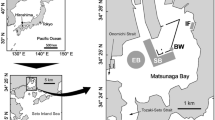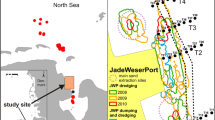Abstract
Because hydrodynamic regimes influence community assemblages, commercial ferry traffic can directly affect neighboring marine ecosystems by altering water movement. One of the largest ferry fleets in the world traverses the calm, protected waters of the Canadian Gulf Islands (British Columbia). To address the effects of ferry wakes on rocky marine intertidal communities, we examined community assemblages in sites impacted by ferry wakes (N = 5) relative to geographically similar control sites not directly exposed to ferry wakes (N = 6). Intertidal communities were significantly different between wake-influenced and control sites. Further analyses revealed that community level differences resulted from differences in seaweed assemblages, while invertebrate assemblages were similar. Sites exposed to ferry traffic displayed significantly greater overall seaweed abundance and seaweed species richness. Nitrate and nitrite concentrations, salinity, fetch, and tidal zonation were not significantly different between wake-impacted and control sites. However, dissolution blocks revealed that wake-impacted sites experienced increased overall water movement. Furthermore, block dissolution was negatively associated with distance from nearest ferry route and not fetch. Although dissolution block cannot disentangle effects of increased flow versus waves resulting from ferry wakes, we conclude that increased overall water movement from frequent and proximate ferry traffic stimulates primary production in rocky intertidal marine seaweeds by ameliorating mass transfer limitation.




Similar content being viewed by others
References
Biber, P. D. & E. A. Irlandi, 2006. Temporal and spatial dynamics of macroalgal communities along an anthropogenic salinity gradient in Biscayne Bay (Florida, USA). Aquatic Botany 85: 65–77.
Bishop, M. J., 2005. Compensatory effects of boat wake and dredge spoil disposal on assemblages of macroinvertebrates. Estuaries 28(4): 510–518.
Bishop, M., 2007. Impacts of boat-generated waves on macroinfauna: Towards a mechanistic understanding. Journal of Experimental Marine Biology and Ecology 343: 187–196.
Bishop, M. & M. Chapman, 2004. Managerial decisions as experiments: an opportunity to determine the ecological impact of boat-generated waves on macrobenthic infauna. Estuarine, Coastal and Shelf Science 61: 613–622.
Boizard, S. D. & R. E. DeWreede, 2006. Inexpensive water motion measurement devices and techniques and their utility in macroalgal ecology: a review. Science Asia 32: 43–49.
Blamey, L. K. & G. M. Brance, 2009. Habitat diversity relative to wave action on rocky shores: implications for the selectin of marine protected area. Aquatic Conservation: Marine and Freshwater Ecosystems 19: 645–657.
Burrows, M. T., R. Harvey & L. Robb, 2008. Wave exposure indices from digital coastlines and the prediction of rocky shore community structure. Marine Ecology Progress Series 353: 1–12.
Burkepile, D. E. & M. E. Hay, 2006. Herbivore vs. nutrient control of marine primary producers: context-dependent effects. Ecology 87(12): 3128–3139.
Bustamante, R. & G. Branch, 1996. Large scale patterns and trophic structure of southern African rocky shores: the roles of geographic variation and wave exposure. Journal of Biogeography 23: 339–351.
Carpenter, R. C. & S. L. Williams, 2007. Mass transfer limitation of photosynthesis of coral reef algal turfs. Marine Biology 151: 435–450.
Carrington, E., 1990. Drag and dislodgement of an intertidal macroalga: consequences of morphological variation in Mastocarpus papillatus Kützing. Journal of Experimental Marine Biology and Ecology 139: 185–200.
Connell, J. H., 1978. Diversity in Tropical Rain Forests and Coral Reefs High diversity of trees and corals is maintained. Science 199(4335): 1302–1310.
Denny, M. W., 1988. Biology and the Mechanics of the Wave-Swept Environment. Cambridge University Press, Cambridge, UK.
Denny, M. W., 1993. Air and Water: The Biology and Physics of Life’s Media. Princeton University Press, Princeton, USA.
Denny, M. W., L. P. Miller, M. D. Stokes, L. J. H. Hunt & B. S. T. Helmuth, 2003. Extreme water velocities: topographical amplification of wave-induced flow in the surf zone of rocky shores. Limnology and Oceanography 48: 1–8.
Eriksson, B. K., A. Sandström, M. Isæus, H. Schreiber & P. Karås, 2004. Effects of boating activities on aquatic vegetation in the Stockholm archipelago, Baltic Sea. Estuarine Coastal and Shelf Science 61: 339–349.
Foster, M. S., 1975. Algal succession in a Macrocystis pyrifera forest. Marine Biology 32: 313–329.
Gabel, F., X.-F. Garcia, M. Brauns, A. Sukhodolov, M. Leszinski & M. T. Pusch, 2008. Resistance to ship-induced waves of benthic invertebrates in various littoral habitats. Freshwater Biology 53: 1567–1578.
Gabel, F., S. Stoll, P. Fischer, M. T. Pusch & X.-F. Garcia, 2011. Waves affect predator–prey interactions between fish and benthic invertebrates. Oecologia 165: 101–109.
Gabrielson, P. W., T. B. Widdowson, S. C. Lindstrom, 2006. Keys to the Seaweeds and Seagrasses of Southeast Alaska, British Columbia, Washington, and Oregon. University of British Columbia Dept. of Botany (Phycological contributions), Vancouver, Canada.
Gerard, V. A., 1984. The light environment in a giant kelp forest: influence of Macrocystis pyrifera on spatial and temporal variability. Marine Biology 84: 189–195.
Harley, C. D. G. & B. S. T. Helmuth, 2003. Local- and regional-scale effects of wave exposure, thermal stress, and absolute versus effective shore level on patterns of intertidal zonation. Limnology and Oceanography 48: 1498–1508.
Hay, M. E., 1986. Functional geometry of seaweeds: ecological consequences of thallus laying and shape in contrasting light environments. In Givnish, T. J. (ed.), On the Economy of Plant Form and Function. Cambridge University Press, Cambridge: 635–666.
Hay, M. E. & W. Fenical, 1988. Marine plant-herbivore interactions: the ecology of chemical defense. Annual Review Ecology and Systematics 19: 111–145.
Hurd, C. L., P. J. Harrison & L. D. Druehl, 1996. Effect of seawater velocity on inorganic nitrogen uptake by morphologically distinct forms of Macrocystis integrifolia from wave-sheltered and exposed sites. Marine Biology 126: 205–214.
Hurd, C. L. & C. I. Stevens, 1997. Flow visualization around single- and multiple-bladed seaweeds with various morphologies. Journal of Phycology 33: 360–367.
Kautsky, L. & H. Kautsky, 1989. Algal species diversity and dominance along gradients of stress and disturbance in marine environments. Vegetatio 83: 259–267.
Koehl, M. A. R., W. K. Silk, H. Lian & L. Mahadevan, 2008. How kelps produce blade shapes suited to different flow regimes: a new wrinkle. Integrative and Comparative Biology 48: 834–851.
Lapointe, B. E., 1997. Nutrient thresholds for bottom-up control of macroalgal Jamaica and southeast Florida. Limnology and Oceaongraphy 42: 1119–1131.
Lapointe, B. E., 1999. Simultaneous top-down and bottom-up forces control macroalgal blooms on coral reefs (Reply to the comment by Hughes et al.). Limnology and Oceanography 44(6): 1586–1592.
Lenihan, H. S., C. H. Peterson & J. M. Allen, 1996. Does flow speed also have a direct effect on growth of active suspension-feeders: an experimental test on oysters. Limnology and Oceanography 41: 1359–1366.
Leonard, G. H., J. M. Levine, P. R. Schmidt & M. D. Bertness, 1998. Flow-driven variation in intertidal community structure in a Maine estuary. Ecology 79: 1395–1411.
Lubchenco, J., 1978. Plant species diversity in a marine intertidal community: Importance of herbivore food preference and algal competitive abilities. American Naturalist 112: 23–39.
Lubchenco, J., 1980. Algal zonation in the New England rocky intertidal community: an experimental analysis. Ecology 61: 333–344.
Mass, T., A. Genin, U. Shavit, M. Grinstein & D. Tchernov, 2010. Flow enhances photosynthesis in marine benthic autotrophs by increasing the efflux of oxygen from the organism to the water. Proceedings of the National Academy of Sciences 107(6): 2527–2531.
McQuaid, C. D. & G. M. Branch, 1984. Influence of sea temperature, substratum, and wave exposure on rocky intertidal communities: an analysis of faunal and floral biomass. Marine Ecology Progress Series 19: 145–151.
Menge, B., 2000. Top-down and bottom-up community regulation in marine rocky intertidal habitats. Journal of Experimental Marine Biology and Ecology 250: 257–289.
Nishihara, G. N. & R. Terada, 2010. Species richness of marine macrophytes is correlated to a wave exposure gradient. Phycological Research 58: 280–292.
Parnell, K. & H. Kofoed-Hansen, 2001. Wakes from large high-speed ferries in confined coastal waters: management approaches with examples from New Zealand and Denmark. Coastal Management 29: 217–237.
Patterson, M. R., 1992. A mass transfer explanation of metabolic scaling relations in some aquatic invertebrates and algae. Science 255(5050): 1421.
Rönnberg, O., 1975. The effects of ferry traffic on rocky shore vegetation in the southern Åland Archipelgao. Merentutkimuslait Julk Havsforskningsinst Skr 239: 325–330.
Soomere, T., 2005. Fast ferry traffic as a qualitatively new forcing factor of environmental processes in non-tidal sea areas: a case study in Tallinn Bay, Baltic Sea. Environmental Fluid Mechanics 5: 293–323.
Soomere, T., 2009. Long ship waves in shallow water bodies. In Quak, E. & T. Soomere (eds), Applied Wave Mathematics. Springer, Berlin: 193–227.
Soomere, T., K. E. Parnell & I. Didenkulova, 2009. Implications of fast-ferry wakes for semi-sheltered beaches: a case study at Aegna Island, Baltic Sea. Journal of Coastal Research 56: 128–132.
Steneck, S. & M. N. Dethier, 1994. A functional group approach to the structure of algal-dominated communities. Oikos 69(3): 476–498.
Steneck, R. S. & L. Watling, 1982. Feeding capabilities and limitation of herbivorous mollusks: a functional group approach. Marine Biology 68: 299–319.
Stephenson, T. A. & A. Stephenson, 1949. The universal features of zonation between tide-marks on rocky coasts. Journal of Ecology 37(2): 289–305.
Stevens, C. L. & C. L. Hurd, 1997. Boundary-layers around bladed aquatic macrophytes. Hydrobiologia 346: 119–128.
Stewart, H. L. & R. C. Carpenter, 2003. The effects of morphology and water flow on photosynthesis of marine macroalgae. Ecology 84(11): 2999–3012.
Thomas, F. I. M., C. D. Cornelisen & J. M. Zande, 2000. Effects of water velocity and canopy morphology on ammonium uptake by seagrass communities. Ecology 81(10): 2704–2713.
Thompson, T. L. & E. P. Glenn, 1994. Plaster standards to measure water motion. Limnology and Oceaongraphy 39: 1768–1779.
Thomsen, M. S., T. Wernberg & G. A. Kendrick, 2004. The effect of thallus size, life stage, aggregation, wave exposure and substratum conditions on the forces required to break or dislodge the small kelp Ecklonia radiata. Botanica Marina 47: 454–460.
Trager, G., Y. Achituv & A. Genin, 1994. Effects of prey escape ability, flow speed, and predator feeding mode on zooplankton capture by barnacles. Marine Biology 120: 251–259.
Wall, L. M., L. J. Walters, R. E. Grizzle & P. E. Sacks, 2005. Recreational boating activity and its impact on the recruitment and survival of the oyster Crassostra virginica on intertidal reefs in Mosquito Lagoon, Florida. Journal of Shellfish Research 24(4): 965–973.
Willby, N. J., J. R. Pygott & J. W. Eaton, 2001. Inter-relationships between standing crop, biodiversity and trait attributes of hydrophytic vegetation in artificial waterways. Freshwater Biology 46: 883–902.
Wing, S. R. & M. R. Patterson, 1993. Effects of wave-induced lightflecks in the intertidal zone on photosynthesis in the macroalgae Postelsia palmaeformis and Hedophyllum sessile (Phaeophyceae). Marine Biology 116: 519–525.
Acknowledgements
The authors would like to thank Chris Harley, Kerry Nickols, Stefan Storey, and Emily Carrington for their helpful comments throughout the course of this project; Mike Burrows, Ally Thompson, and Chris Lee for their help with the map creation and fetch analyses; and Mary O’Connor, Rebecca Martone, Jonathan Pruitt, and Helen Demes for their constructive criticism on earlier versions of this manuscript. Funding was provided by the National Science and Engineering Research Council grant to Christopher Harley.
Author information
Authors and Affiliations
Corresponding author
Additional information
Handling editor: Stuart Jenkins
Rights and permissions
About this article
Cite this article
Demes, K.W., Kordas, R.L. & Jorve, J.P. Ferry wakes increase seaweed richness and abundance in a sheltered rocky intertidal habitat. Hydrobiologia 693, 1–11 (2012). https://doi.org/10.1007/s10750-012-1082-4
Received:
Revised:
Accepted:
Published:
Issue Date:
DOI: https://doi.org/10.1007/s10750-012-1082-4




